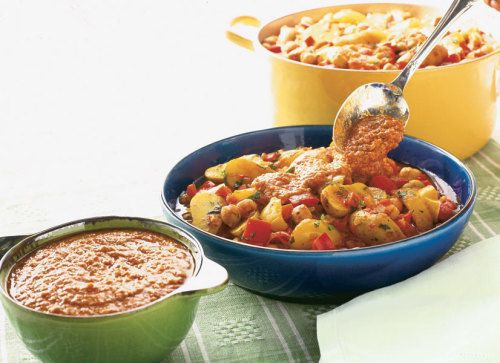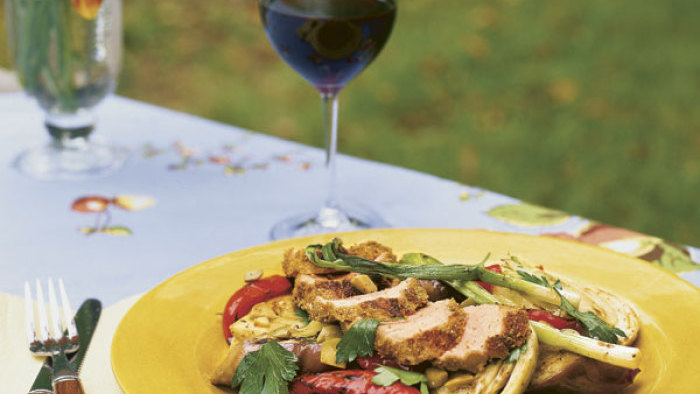
by Deborah Madison
April 1997
from issue #8
Many people rely on stir-fries for an easy weeknight meal, but I usually prefer a more slowed-down version of the vegetable mélange. That’s why I make ragoûts and stews (the words even rhyme). These dishes—they’re essentially the same thing—simmer lazily over low heat in a heavy pan or casserole. Time is one of the elements that add flavor to the dish. I like to think of it as the hidden ingredient. Half an hour or more at a slow bubble allows the ingredients to blend their characters into a flavor that is larger than the sum of the individual parts. Yet these are not cumbersome, time-consuming recipes to prepare. Most of them take less than an hour. And while the stew is simmering on the stove, I can be putting together a salad or making a dessert.
I believe that if you use vegetables that are in season together, you can’t possibly go wrong. This is a real benefit to the home gardener, for virtually everything that’s harvestable at any one time tastes good together, whereas at the supermarket, vegetables are all mixed up with regard to season. You can relax about quantities, too, for this type of dish happily accepts a fistful of peas or the last of the tomatoes as easily as it handles an abundance of beans or squash.
Vegetable stews aren’t limited to cool seasons. For me, they are year-round dishes. A single pot cooking over low heat for 30 minutes won’t heat up the summer kitchen. And there’s no rule that these dishes must be eaten piping hot. Summer stews are good warm or at room temperature. Consider the well-known Provençal ragoût—ratatouille, which combines eggplant, zucchini, peppers, onions, and tomatoes. These same vegetables appear in various stew-like combinations throughout the Mediterranean, but with different personalities expressed by the addition of chickpeas or white beans, a change of herb, or the added nuance of saffron, preserved lemon, or olives. A New World summer stew might be based on corn, peppers, tomatoes, and okra.
When it comes to vegetables that have both a spring and a fall season, like fennel, leeks, potatoes, and artichokes, I compose different stews using the same basic cast plus a few seasonal extras. The dish featured here becomes a ragoût for spring with the addition of peas or fava beans, a creamy mustard sauce, and chopped fennel greens for garnish. A few months later, I’ll make a fall version that includes celery root, carrots, or rutabagas.
Winter, the traditional stew season, offers hearty root vegetables—parsnips, rutabagas, celery root, carrots, parsley root, Jerusalem artichokes—which I like to cook on a base of caramelized onions and then simmer in red wine.
Slow cooking yields great flavor
A longer, slower cooking breaks down the fibrous texture of vegetables, and also draws out their flavors, mingling essences and caramelizing sugars. There’s no reason for a vegetable stew to be mushy and dull, though. Adding acid in the form of wine or lemon juice helps the vegetables retain some firmness, even as they become tender. Cooking in stages—adding peas at the last minute, for example—can provide a contrast of textures in a dish.
However, if you’re not afraid of losing crispness, you’ll be well repaid with flavor. One of the most memorable vegetable dishes I’ve ever eaten was a braise of artichokes, fava beans, and peas that I enjoyed in Rome a few years back. The dish had been cooked until no particular vegetable was identifiable. The texture was near purée soft, but that didn’t matter; the flavor was sumptuous and astonishingly vivid.
I start with a base of oniony things—shallots, leeks, onions, or scallions—plus garlic, herbs, and aromatic vegetables, letting them cook in butter or olive oil. I let them brown a bit for robust winter dishes but not for summer stews, where a lighter flavor and color are more appropriate. Then I usually add other vegetables in the order of their cooking time, from the slowest to the fastest. Unless I’m using plenty of very juicy produce, like summer tomatoes, I add water or broth, put on the lid, and let everything simmer until tender, usually another 20 to 30 minutes.
Add a starch and you’ve got a meal
As they cook, the vegetables produce their own sweet, residual juices. Sometimes I augment the finished stew with a knob of herb butter, a drizzle of salsa verde, a squeeze of lemon, or a dash of vinegar to bring everything into sharper relief. Then I add a starch, and I have a meal. A large, garlic-rubbed crouton is one of my favorite accompaniments. Its crispness makes a good contrast to the soft vegetables. But rice, polenta, popovers, cornbread, biscuits, or a mound of mashed potatoes makes a good partner, too.


















Comments
Log in or create an account to post a comment.
Sign up Log in